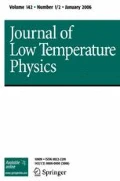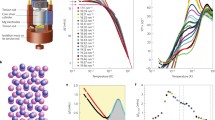Abstract
We calculate the thermodynamics of superfluid 4He at negative pressures. We use the Landau theory in which thermodynamic properties are expressed as sums over the thermal distribution of elementary excitations. The excitation dispersion curve is taken from the density functional theory developed by Dalfovo et al. To give a good description of the liquid near to the lambda line, we include the interaction between the elementary excitations using a modification of the roton liquid theory of Bedell, Pines, and Fomin. The calculated quantities include the location of the lambda line, the liquid-vapor spinodal, and lines of constant entropy in the pressure-temperature (P-T) plane. We have also calculated the line of minimum density (zero expansion coefficient) in theP-T plane. This joins the lambda line tangentially at about −5.3 bars. Using the critical properties near the lambda line, we find that the line of maximum density in He I also joins the lambda line tangentially at this pressure. For use in cavitation experiments, we have calculated the states on the lambda line reached by isentropic expansion from He I.
Similar content being viewed by others
REFERENCES
For a review, see H. J. Maris, in Proceedings of the 21st International Conference on Low Temperature Physics, Prague, August 1996, Czech. J. Phys. S6, 2943 (1996).
H. J. Maris and S. Balibar, Physics Today 53, 29 (2000).
S. Balibar, C. Guthmann, H. Lambare, P. Roche, E. Rolley, and H. J. Maris, J. Low Temp. Phys. 101, 271 (1995).
S. Balibar, F. Caupin, P. Roche, and H. J. Maris, J. Low Temp. Phys. 113, 459 (1998).
S. Balibar and X. Chavanne, unpublished.
S. C. Hall and H. J. Maris, J. Low Temp. Phys. 107, 263 (1997).
L. D. Landau, J. Phys. Moscow 5, 71 (1941).
G. H. Bauer, D. M. Ceperley, and N. Goldenfeld, Phys. Rev. 61, 9055 (2000).
V. P. Skripov, Zh. Fiz. Khim. 68, 1382 (1994) [Russ. J. Phys. Chem. 68, 1252 (1994); Usp. Fiz. Nauk 170, 559 (2000); Phys.-Uspekhi 43, 515 (2000)].
B. M. Abraham, Y. Eckstein, J. B. Ketterson, M. Kuchnir, and P. R. Roach, Phys. Rev. A1, 250 (1970).
H. J. Maris, Phys. Rev. A5, 2629 (1973).
Q. Xiong and H. J. Maris, J. Low Temp. Phys. 77, 347 (1989).
H. J. Maris, J. Low Temp. Phys. 94, 111 (1994).
F. Dalfovo, A. Lastri, L. Pricaupenko, S. Stringari, and J. Treiner, Phys. Rev. B52, 1193 (1995). The equation of state is given in Eq. (13) of this reference. Using the density functional scheme as described there, we have been unable to obtain perfect agreement with the dispersion curve and static response function that they show in their Figs. 1 and 12. For example, we calculate a roton gap that is about 1% higher than shown in their Fig. 12.
The way in which the sound velocity goes to zero as the spinodal is approached is an open question. For alternative viewpoints, see M. A. Solis and J. Navarro, Phys. Rev. 45, 13080 (1992) and C. E. Campbell, R. Folk, and E. Krotscheck, J. Low Temp. Phys. 105, 13 (1996). Different assumptions about the way the sound velocity varies as one approached the spinodal pressure lead to slightly different values of P c.
J. Boronat, J. Casulleras, and J. Navarro, Phys. Rev. B50, 3427 (1994).
See, for example, H. R. Glyde, Excitations in Liquid and Solid Helium, Oxford University Press, Oxford (1994).
A path-integral Monte Carlo calculation of the excitation energy for the single density 0.114 g cm−3 and a temperature of 1 K was performed by Bauer et al. (Ref. 9). They found the energy at the roton minimum to be approximately 1 K lower than in the Dalfovo et al. model. Their result for the maxon energy was also lower. A diffusion Monte-Carlo calculation by J. Boronat and J. Casulleras (J. Low Temp. Phys. 110, 443 (1998)) for a density of 0.113 g cm−3 is also in reasonable agreement with the results shown in Fig. 4. At the minimum, their roton energy is about 2 K above that shown in Fig. 4. The statistical error is about 1 K.
P. J. Bendt, R. D. Cowan, and J. L. Yarnell, Phys. Rev. 113, 1386 (1959).
J. Maynard, Phys. Rev. B14, 3868 (1976).
R. J. Donnelly and P. H. Roberts, J. Low Temp. Phys. 27, 687 (1977).
K. Bedell, D. Pines, and I. Fomin, J. Low. Temp. Phys. 48, 417 (1982).
K. Bedell, D. Pines, and A. Zawadowski, Phys. Rev. B 29, 102 (1984).
K. Fukushima and F. Iseki, Phys. Rev. B 38, 4448 (1988).
G. Ahlers, Phys. Rev. A8, 530 (1973).
H. A. Kierstead, Phys. Rev. 126, 153 (1967).
O. V. Lounasmaa, Cryogenics 1, 1 (1961).
See J. Wilks, The Properties of Liquid and Solid Helium, Oxford, London (1967).
J. S. Brooks and R. J. Donnelly, J. Phys. Chem. Ref. Data 6, 51 (1977).
R. De Bruyn Ouboter and C. N. Yang, in Physica B44, 127 (1987).
See J. A. Lipa, D. R. Swanson, J. A. Nissen, T. C. P. Chui, and U. E. Israelsson, Phys. Rev. Lett. 76, 944 (1996) and the references therein.
M. Campostrini, A. Pelissetto, P. Rossi, and E. Vicari, Phys. Rev. B 61, 5905 (2000).
Author information
Authors and Affiliations
Rights and permissions
About this article
Cite this article
Maris, H.J., Edwards, D.O. Thermodynamic Properties of Superfluid 4He at Negative Pressure. Journal of Low Temperature Physics 129, 1–24 (2002). https://doi.org/10.1023/A:1020060700534
Issue Date:
DOI: https://doi.org/10.1023/A:1020060700534



